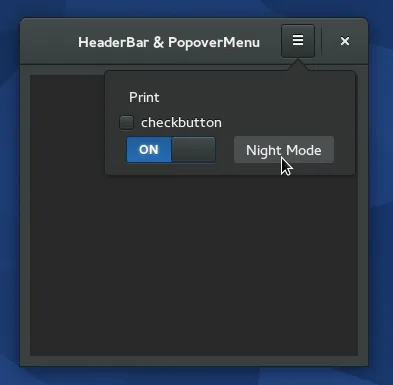我正在尝试创建一个合适的
特别是这句话对我来说毫无意义:
下面是Python代码:
Gtk.HeaderBar示例,其中包含Gtk.PopoverMenus,以展示不同的小部件如何使用。我查看了很多示例和代码,但无法弄清楚如何使用Gtk.ModelButton。特别是这句话对我来说毫无意义:
无论如何,这里是我的尝试,只使用常规小部件在PopoverMenu中,导致突出显示不一致(整行应该被突出显示):当通过“action-name”和“action-target”属性指定操作时,按钮的角色(即它是普通按钮、复选框还是单选按钮)由操作的类型确定,并且不必使用“role”属性显式指定。

ModelButtons成为适当的PopoverMenu小部件的子类?下面是Python代码:
from gi.repository import Gtk, Gio
class HeaderBarWindow(Gtk.Window):
def __init__(self):
Gtk.Window.__init__(self, title="HeaderBar & PopoverMenu")
self.set_border_width(10)
self.set_default_size(400, 400)
builder = Gtk.Builder()
objects = builder.add_objects_from_file("popovermenu_layout.xml", ("pom_options", ""))
pom_opt = builder.get_object("pom_options")
builder.connect_signals(self)
hb = Gtk.HeaderBar()
hb.set_show_close_button(True)
hb.props.title = "HeaderBar & PopoverMenu"
self.set_titlebar(hb)
def on_click(button, popovermenu):
"""
Toggles the respective popovermenu.
"""
if popovermenu.get_visible():
popovermenu.hide()
else:
popovermenu.show_all()
button_opt = Gtk.Button()
icon = Gio.ThemedIcon(name="format-justify-fill-symbolic")
image = Gtk.Image.new_from_gicon(icon, Gtk.IconSize.BUTTON)
button_opt.add(image)
hb.pack_end(button_opt)
pom_opt.set_relative_to(button_opt)
button_opt.connect("clicked", on_click, pom_opt)
self.add(Gtk.TextView())
def print_something(self, modelbutton, event):
print("you pressed a button")
def night_mode_switcher(self, switch, state):
Gtk.Settings.get_default().set_property("gtk-application-prefer-dark-theme", state)
win = HeaderBarWindow()
win.connect("delete-event", Gtk.main_quit)
win.show_all()
Gtk.main()
以下是PopoverMenu的模型:
<interface>
<object class="GtkPopoverMenu" id ="pom_options">
<child>
<object class="GtkBox">
<property name="visible">True</property>
<property name="margin">10</property>
<property name="orientation">vertical</property>
<child>
<object class="GtkModelButton" id="mb_print">
<property name="visible">True</property>
<property name="text" translatable="yes">Print</property>
<property name="can_focus">True</property>
<property name="receives_default">True</property>
<signal name="button-press-event" handler="print_something" swapped="no"/>
</object>
</child>
<child>
<object class="GtkCheckButton" id="checkbutton1">
<property name="label" translatable="yes">checkbutton</property>
<property name="visible">True</property>
<property name="can_focus">True</property>
<property name="receives_default">False</property>
<property name="draw_indicator">True</property>
</object>
</child>
<child>
<object class="GtkBox" id="box1">
<property name="visible">True</property>
<property name="can_focus">False</property>
<child>
<object class="GtkSwitch" id="switch1">
<property name="visible">True</property>
<property name="can_focus">True</property>
<signal name="state-set" handler="night_mode_switcher" swapped="no"/>
<property name="margin_start">9</property>
<property name="margin_end">9</property>
</object>
<packing>
<property name="expand">False</property>
<property name="fill">True</property>
<property name="position">0</property>
</packing>
</child>
<child>
<object class="GtkModelButton" id="mb_night">
<property name="text" translatable="yes">Night Mode</property>
<property name="visible">True</property>
<property name="can_focus">False</property>
<property name="margin_start">9</property>
<property name="margin_end">9</property>
</object>
<packing>
<property name="expand">True</property>
<property name="fill">True</property>
<property name="position">1</property>
</packing>
</child>
</object>
</child>
</object>
</child>
</object>
</interface>